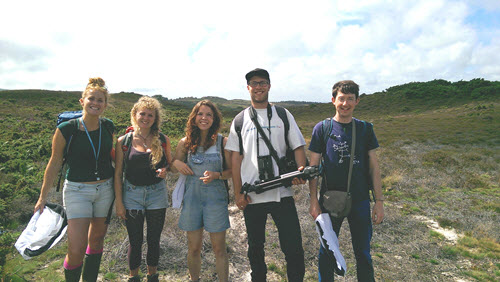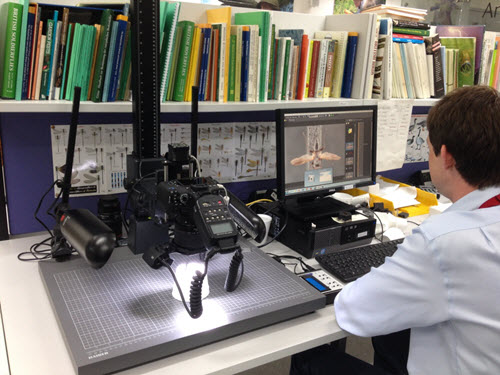The last stages of Phase 2
Written by Mike Waller, ID Trainer for the Future Trainee
May I introduce you to the final instalment from myself, Mike Waller, on the exciting activities of the ID Trainers during the twilight of Phase 2. I’ll start with a short introduction to what I’m about.
My fascination with wildlife has always been strong but over the last 12 years, I’ve developed a particular interest in terrestrial orchids and botany in general. I’m also a birdwatcher and former RSPB ‘Young Birder of the year’. After graduating from Aberystwyth with a degree in Physical Geography, I worked for the RSPB and Wildlife Trusts drumming up support and spreading the word of conservation. Now I have the dream position, nestled amongst the Natural History Museum experts strengthening my identification knowledge across the board. In fact, it’s been a rollercoaster of learning, public engagement and field work and especially during the latter half of July through to the end of August. So what exactly have we been doing since Katy's last update?
Dorset field trip
On the Monday morning of the 20th of July, we all headed down to Dorset for a 3-day fieldtrip with our wonderful project manager, Steph West and museum botanists, Fred Rumsey and Mark Spencer. The plan was to do a mix of botanising, mothing (with the museum moth experts Geoff Martin and Allesandro Giusti) and batting (with Steph who is bat-crazy!). Steph introduced us to the world of UK bats and using her bat detectors, before we set out to scour the quiet lanes of Langton Matravers in search of the tell-tale clicks that represent a nearby bat echo-locating. Unfortunately it was rather windy and we only located Pipistrelles, but we did get some very close flypasts.

The first full day was spent surveying for Drosera (sundew) hybrids and Bog orchids at Godlingston Heath – the latter was of course very exciting for me and in the end we counted 102 flowering spikes which is FAR better than the 18 spikes seen in 2013. Some of us were, shall we say, a little ‘ungainly’ in the particularly wet areas of the bog and this showed by the end of the day!
That evening, Geoff and Allesandro arrived and we deployed various types of moth trap to investigate which design is more effective. Early in the morning, we got up and collected the moths sitting around the traps to avoid hungry birds snatching them and the following day we collected and emptied the traps themselves, putting as many species as we could into pots for identification which was fantastic fun!
We spent the rest of the day balancing on tussocks in another soaking bog looking for Dorset Heath and alien-like Utricularias (Bladderworts) – one of which is extremely rare and was flowering in abundance! We all headed back to London with rosy cheeks and plenty of photographs.
Tring Bioblitz
Without barely a moment to spare, we whisked ourselves off to Tring on the following Saturday to assist with their 2nd Bioblitz. Tring in Hertfordshire, is the location of the old Walter Rothschild’s museum now owned and run by Natural History Museum. It is also a research institute with a focus on ornithology meaning the entire bird collection is also stashed there.
This was a really great day with fine weather and plenty of keen budding naturalists. It was a superb opportunity to bolster our people engagement skills whilst also going fully mental with collecting insects! Katy was especially pleased with the Devil’s Coach-horse I found for her. During the plant walks I conducted, I managed to locate some Pyramidal and Bee orchids in the nearby Museum meadow.
Hymenoptera workshop
The following week saw the last in our invertebrate workshops and what better to finish on than Hymenoptera with their Museum curator, Gavin Broad. He took us through the use of keys and gave a superb presentation on wasps which was fascinating – especially the life histories of his beloved Ichneumonids! We also had a day out at Barnes Common collecting which was very fun. Over the whole course, I managed to ID ONE of the wasps I collected to species level – an indication of quite how difficult identification is in this group!
Citizen Science and Identification Advisory Service (IAS)
Since then we’ve all been carrying on with our citizen science projects which are all at different stages of life, from just launched to closing down. I’ve been working on Orchid Observers which, for me, is in many ways a dream come true. I’ve been photographing wild orchids for years, so to be directly working on and promoting a project that focuses on just that has been wonderful. This has involved publicity work, writing blog posts and assisting with the running of the website. I’ve even been lucky enough to have had many of my photographs published in the ID guide and in various media articles.
Alongside the citizen science, we’ve all been enlisted to help the IAS team with answering public enquiries and cataloguing the vast quantity of fossils bequeathed to us by Queen Mary University. It’s been a really valuable experience to gain an understanding of the other lines of work within the Angela Marmont Centre (AMC) where we’re based.
Providing up-to-date information to the public is of utmost importance and this is achieved by the IAS in a number of ways. Most effectively is the production of factsheets on species of particular public interest such as common pests and non-native species. Of course, this means we’ve all been working to strike some of the target species or groups off the list with our own factsheets on things like British Snakes, the Hummingbird Hawk-moth, Dog -sick Slime Mould and Death-watch Beetle.
Keys
As I write this, we’re also delving into the world of key-writing, individually focussing on a species group for which a good quality key is currently unavailable. Fred has tasked me with writing an updated key to the fruits of docks (Rumex) whilst the other trainees are writing keys for small groups in Diptera and Hymenoptera. Using the image stacking equipment here in the office, we can take extremely detailed macro photographs of miniscule specimens to illustrate our hopefully very functional and useful keys!

However, it’s now only a week before we all separate and drift away to various corners of the museum to begin our curation placements. This will last 3 months by which time we will have begun to specialise in our chosen curation species group. In my case, that will be lichens alongside my tutor, Holger Thues – a man of famously capacious wisdom and knowledge in the field of lichens! I think I speak for all of us in saying we’ll be very sad to leave the AMC and all the wonderful people we’ve been working with there over the last 6 months. Not only have we gained an array of varied skills and advice from them, but also great friendships and memories, but we’ll be back again in 3 months time for the final stage of our traineeship.
For now, bring on phase 3!
A note from the Project Manager:
Do you know someone who could be one of our next trainees? We are going to be recruiting for the second cohort of trainees, who will start with us in March 2016, very soon. Applications will be open from the 14th September to the 12th October and we still have a few spaces on our taster sessions on the 22nd September and 6th October. Please see our webpage for full details of the project and how to apply.
Steph West
